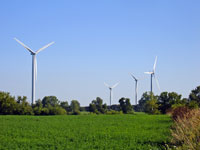Wind power
The DNR fully supports the siting, development and use of clean and renewable energy facilities based on sound scientific information and in a manner that is sustainable for wildlife and other natural resources.
Wind projects pose different siting issues than combustion-based electric generation facilities. Wind projects require larger areas of land per megawatt of generation. The interaction of birds and bats with wind turbine blades and related facilities is a well-documented impact concern.
Siting authority
Field Wind project in Fond du
Lac County. © WE Energies.
The DNR does not have authority over the siting of wind projects. The Wisconsin Public Service Commission (PSC) must approve wind projects that are 100 megawatts (MW) or larger or those built by a state-regulated utility. Other wind projects must be approved by the local government, but must adhere to PSC wind siting criteria.
The DNR has regulatory authority for any wetland and waterway crossings by temporary and permanent access roads, connector lines and turbine construction. We also have authority over construction site erosion control, and the protection of state-listed threatened and endangered species.
The DNR works with the PSC through a cooperative agreement. This ensures that both agencies share information and make timely decisions. Department staff also assist the PSC in reviewing applications, writing environmental review documents and providing expert testimony before the Commission. The DNR's authorities and responsibilities are described in a report to the legislature required by Act 40.
DNR contacts and guidance
We urge wind project developers to contact the DNR's Environmental Analysis and Sustainability program as early as possible during site selection and throughout project development in order to minimize the potential for impacts on wildlife. Wind developers should also contact the USFWS Field Office for Wisconsin to evaluate wildlife risks and ways to reduce potential adverse impacts.
The DNR has developed Guidance for Minimizing Impacts to Natural Resources from Terrestrial Commercial Wind Energy Development to aid in the planning of commercial wind energy facilities. Commercial wind installations are those with an installed nameplate capacity greater than 300 kilowatts (kW) and that consists of turbines with a nameplate capacity of more than 100 kW. The guidance was developed to help wind project reviewers, planners and owners identify areas that are not suitable for wind development, address potential impacts, and prevent unwanted and avoidable conflicts with area or site-specific natural resource management objectives.
We invite the public to comment on our wind project guidance. Comments may be sent to DNROEEAComments@wisconsin.gov.
Bird and bat impacts
The DNR has both a regulatory and a conservation responsibility to respond to concerns about wind turbine impacts on bats and birds. These concerns include:
- high fatality rates for bat species already at risk from white-nose syndrome,
- bird fatalities for species that are rare or have declining populations,
- the potential for large fatality events during bat and bird migrations,
- habitat loss and fragmentation; and
- displacement of bats and birds from large or important areas of their aerial or terrestrial habitat.
The DNR legally protects state-listed threatened or endangered species under Wisconsin's Threatened and Endangered Species Law. We also have a responsibility to preserve and enhance the environment for other species and natural communities not covered by this law. There are several bird and bat species currently on the state's list of threatened or endangered species that may be affected by wind projects. We can work with developers to avoid impacts to these species or evaluate them under the incidental take permitting process. We also cooperate with the USFWS in their administration and enforcement of federal laws including the federal Endangered Species Act and the Migratory Bird Treaty Act.
Post-construction studies to measure bat and bird mortality and changes in bird and bat use have been completed at three wind projects in Wisconsin:
Additional resources
- Contact information
- For information on wind power projects, contact:
- Stacy Rowe
Conservation biologist
608-228-9796

